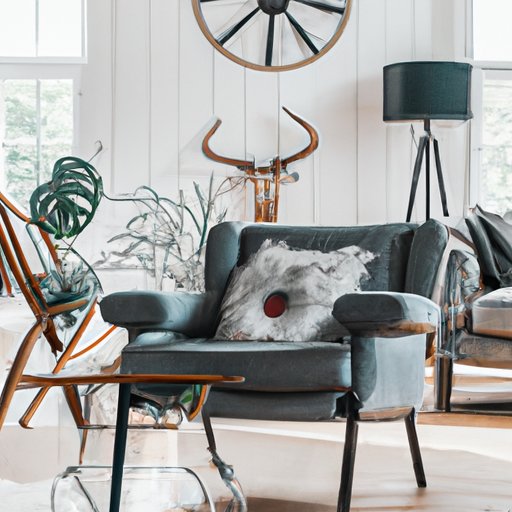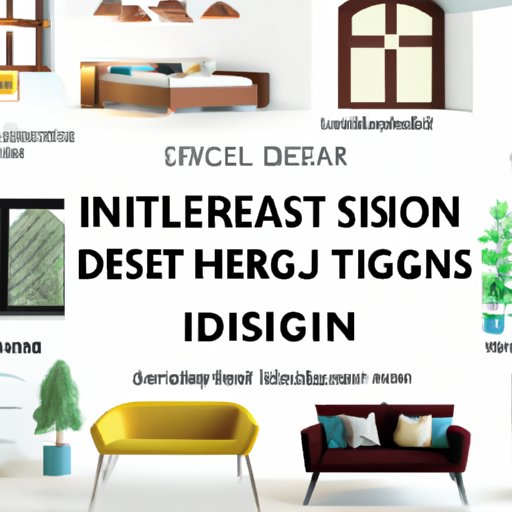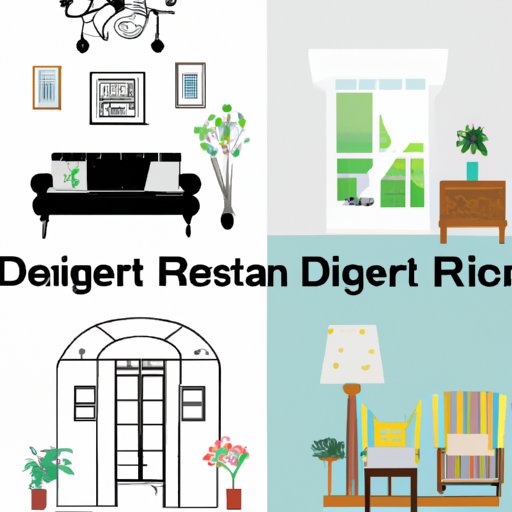Introduction
Interior design is the art and science of enhancing a living space to create a more aesthetically pleasing environment. It involves creating a functional and beautiful space that reflects the personality and lifestyle of its occupants. There are many different interior design styles, each with its own unique look and feel. It can be overwhelming to decide which style will work best for your home, so let’s take a look at some of the most popular interior design styles and how to choose the right one for you.
A Guide to Different Interior Design Styles
From traditional to modern and everything in between, there are a variety of interior design styles available. Here’s a brief overview of some of the most popular ones:
Traditional Interior Design Style
The traditional style is classic and timeless. It incorporates elements such as rich wood furniture, ornate details, and elegant fabrics. The color palette typically consists of warm, muted tones like beige, cream, and brown. This style is perfect for those who prefer a more formal, sophisticated look.
Modern Interior Design Style
The modern style is sleek and minimalistic. It features clean lines, neutral colors, and simple shapes. Furniture pieces are often made of metal or wood, and fabrics are often bold and geometric. This style is great for those who want a contemporary, edgy look.
Minimalist Interior Design Style
The minimalist style is all about simplicity. It emphasizes the use of negative space and stark, clean lines. Neutral colors and natural materials are key components of this style. This style is ideal for those who appreciate a pared-down aesthetic.
Contemporary Interior Design Style
The contemporary style blends elements of both traditional and modern designs. It combines classic pieces with more modern touches to create a unique look. Color palettes usually consist of neutrals and vibrant hues, while furniture pieces may range from sleek and angular to curved and organic. This style is great for those who want to experiment with different looks.
Eclectic Interior Design Style
The eclectic style is all about mixing and matching different design elements. It combines various eras, textures, and colors to create a vibrant, unique look. This style is perfect for those who want to express their individuality and make a bold statement.
Industrial Interior Design Style
The industrial style is characterized by exposed brick, pipes, and beams. It incorporates elements such as concrete, metals, and distressed wood. Colors tend to be muted, with splashes of bright accent colors. This style is great for those who appreciate the raw beauty of unfinished materials.
Mid-Century Modern Interior Design Style
The mid-century modern style is inspired by the 1950s and 1960s. It features organic shapes, clean lines, and pops of bright colors. Furniture pieces are often made of wood and fabric, and lighting fixtures are often retro-inspired. This style is perfect for those who want to bring a touch of nostalgia into their home.
Scandinavian Interior Design Style
The Scandinavian style is inspired by the Nordic countries. It emphasizes the use of light, airy spaces with a focus on functionality. Natural materials such as wood and stone are used, and colors tend to be neutral. This style is great for those who want to create a cozy yet modern atmosphere.

How to Choose the Right Interior Design Style for Your Home
Choosing the right interior design style for your home can be a daunting task. Here are some tips to help you make the right choice:
Consider the Architecture and Layout of Your Home
Before you decide on a specific style, it’s important to consider the architecture and layout of your home. For example, if your home has high ceilings and large windows, a modern or contemporary style might be a good fit. On the other hand, if your home has low ceilings and small windows, a traditional or rustic style might be more appropriate.
Look at Your Personal Preferences
Your personal preferences should also be taken into account when choosing a style. Think about what kind of look you’re going for and what kinds of colors, textures, and patterns appeal to you. Do you prefer a more formal or casual look? Are you drawn to bright and vibrant colors or muted and neutral tones? Answering these questions can help you narrow down your choices.
Think About Your Lifestyle
It’s also important to consider how you live and how you plan to use the space. If you have young children, you may want to opt for a style that is kid-friendly and easy to maintain. If you entertain often, you may want to choose a style that allows for plenty of seating and conversation areas. Taking your lifestyle into account can help you select the right style for your home.
Take into Account Your Budget
Finally, it’s important to keep your budget in mind. Some interior design styles require more expensive materials than others, so make sure you’re aware of the costs before making a decision. You may need to make some compromises in order to stay within your budget, but there are still plenty of options available that won’t break the bank.

Top 10 Interior Design Styles Explained
Now that we’ve gone over some of the basics, let’s take a closer look at the top 10 interior design styles and what makes them unique:
Traditional Interior Design Style
The traditional style is classic and timeless. It incorporates elements such as rich wood furniture, ornate details, and elegant fabrics. The color palette typically consists of warm, muted tones like beige, cream, and brown. This style is perfect for those who prefer a more formal, sophisticated look.
Modern Interior Design Style
The modern style is sleek and minimalistic. It features clean lines, neutral colors, and simple shapes. Furniture pieces are often made of metal or wood, and fabrics are often bold and geometric. This style is great for those who want a contemporary, edgy look.
Minimalist Interior Design Style
The minimalist style is all about simplicity. It emphasizes the use of negative space and stark, clean lines. Neutral colors and natural materials are key components of this style. This style is ideal for those who appreciate a pared-down aesthetic.
Contemporary Interior Design Style
The contemporary style blends elements of both traditional and modern designs. It combines classic pieces with more modern touches to create a unique look. Color palettes usually consist of neutrals and vibrant hues, while furniture pieces may range from sleek and angular to curved and organic. This style is great for those who want to experiment with different looks.
Eclectic Interior Design Style
The eclectic style is all about mixing and matching different design elements. It combines various eras, textures, and colors to create a vibrant, unique look. This style is perfect for those who want to express their individuality and make a bold statement.
Industrial Interior Design Style
The industrial style is characterized by exposed brick, pipes, and beams. It incorporates elements such as concrete, metals, and distressed wood. Colors tend to be muted, with splashes of bright accent colors. This style is great for those who appreciate the raw beauty of unfinished materials.
Mid-Century Modern Interior Design Style
The mid-century modern style is inspired by the 1950s and 1960s. It features organic shapes, clean lines, and pops of bright colors. Furniture pieces are often made of wood and fabric, and lighting fixtures are often retro-inspired. This style is perfect for those who want to bring a touch of nostalgia into their home.
Scandinavian Interior Design Style
The Scandinavian style is inspired by the Nordic countries. It emphasizes the use of light, airy spaces with a focus on functionality. Natural materials such as wood and stone are used, and colors tend to be neutral. This style is great for those who want to create a cozy yet modern atmosphere.
French Country Interior Design Style
The French country style is inspired by the rural French countryside. It features rustic furniture, vintage antiques, and warm, inviting colors. Floral prints, plaids, and stripes are common elements of this style. This style is perfect for those who want to create a cozy and inviting atmosphere.
Mediterranean Interior Design Style
The Mediterranean style is inspired by the coastal regions of the Mediterranean Sea. It incorporates elements such as terracotta tiles, whitewashed walls, and wrought iron accents. Colors tend to be bright and cheerful, with a focus on blues and yellows. This style is great for those who want to bring a touch of the seaside into their home.
The Essential Elements of Each Interior Design Style
No matter which interior design style you choose, there are certain elements that are essential for achieving the desired look and feel. Here’s a quick look at the essential elements of each style:
Traditional Interior Design Style
Essential elements include rich wood furniture, ornate details, and elegant fabrics. Color palettes typically consist of warm, muted tones like beige, cream, and brown.
Modern Interior Design Style
Essential elements include clean lines, neutral colors, and simple shapes. Furniture pieces are often made of metal or wood, and fabrics are often bold and geometric.
Minimalist Interior Design Style
Essential elements include the use of negative space and stark, clean lines. Neutral colors and natural materials are key components of this style.
Contemporary Interior Design Style
Essential elements include classic pieces combined with more modern touches. Color palettes usually consist of neutrals and vibrant hues, while furniture pieces may range from sleek and angular to curved and organic.
Eclectic Interior Design Style
Essential elements include various eras, textures, and colors mixed and matched to create a unique look. This style is perfect for expressing individuality and making a bold statement.
Industrial Interior Design Style
Essential elements include exposed brick, pipes, and beams. Concrete, metals, and distressed wood are key components, and colors tend to be muted with splashes of bright accent colors.
Mid-Century Modern Interior Design Style
Essential elements include organic shapes, clean lines, and pops of bright colors. Furniture pieces are often made of wood and fabric, and lighting fixtures are often retro-inspired.
Scandinavian Interior Design Style
Essential elements include light, airy spaces with a focus on functionality. Natural materials such as wood and stone are used, and colors tend to be neutral.
French Country Interior Design Style
Essential elements include rustic furniture, vintage antiques, and warm, inviting colors. Floral prints, plaids, and stripes are common elements of this style.
Mediterranean Interior Design Style
Essential elements include terracotta tiles, whitewashed walls, and wrought iron accents. Colors tend to be bright and cheerful, with a focus on blues and yellows.

Comparing Traditional and Modern Interior Design Styles
Traditional and modern interior design styles are two of the most popular styles. While they share some similarities, there are also some key differences that set them apart. Here’s a closer look at how the two styles compare:
Differences in Materials Used
The traditional style typically incorporates richer materials such as wood, velvet, and silk, while the modern style tends to favor simpler materials such as metal, glass, and plastic.
Differences in Color Palettes
The traditional style usually features warmer, muted tones like beige, cream, and brown, while the modern style often incorporates brighter, bolder colors like red, orange, and yellow.
Differences in Furniture Styles
Traditional furniture pieces tend to have more ornate details and curvier shapes, while modern pieces are often characterized by clean lines and straight edges.
Differences in Lighting
Traditional lighting fixtures often feature intricate details and elegant silhouettes, while modern lighting fixtures are usually more streamlined and minimalistic.
An Expert’s Overview of Interior Design Styles
To get an insider’s perspective on interior design styles, we spoke with interior designer and HGTV star Taniya Nayak.
(Note: Is this article not meeting your expectations? Do you have knowledge or insights to share? Unlock new opportunities and expand your reach by joining our authors team. Click Registration to join us and share your expertise with our readers.)
